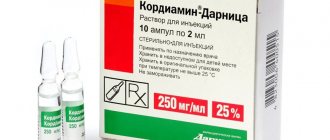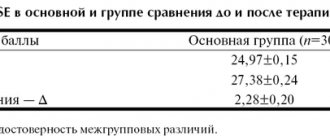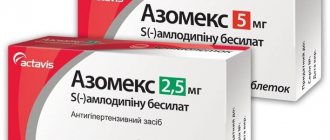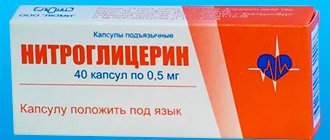Pharmacological properties of the drug Diazepam
A tranquilizer of the benzodiazepine group, it has anxiolytic, sedative, muscle relaxant and anticonvulsant effects, potentiating the effects of the GABAergic system by stimulating the central action of GABA, the main inhibitory neurotransmitter of the brain. Benzodiazepine derivatives act in the same way as benzodiazepine receptor agonists, which form a component of a functional supramolecular unit known as the benzodiazepine-GABA-chlorionophore receptor complex located on the neuronal membrane. Due to the selective stimulating effect on GABA receptors in the ascending reticular formation of the brain stem, it reduces excitation of the cortex, limbic region, thalamus and hypothalamus and has an anxiolytic and sedative-hypnotic effect. Due to its inhibitory effect on polysynaptic spinal reflexes, it has a muscle relaxant effect. Diazepam is quickly and completely absorbed from the digestive tract; the maximum concentration in blood plasma is achieved 30–90 minutes after oral administration. After an intramuscular injection, complete absorption also occurs, although this process is not always faster than after oral administration. The elimination curve of diazepam is biphasic: an initial phase of rapid and widespread distribution with a half-life of up to 3 hours is followed by a long terminal elimination phase (with a half-life of up to 48 hours). Diazepam is metabolized into the pharmacologically active nordiazepam (half-life - 96 hours), hydroxydiazepam and oxazepam. Diazepam and its metabolites are bound to plasma proteins (diazepam 98%); excreted mainly in the urine (about 70%) in the form of free or conjugated metabolites. The half-life may increase in newborns, elderly and senile patients and in patients with liver or kidney disease; however, it may take a longer time to achieve equilibrium concentration in the blood plasma. Diazepam and its metabolites pass through the blood-brain barrier and the placental barrier. They are also detected in breast milk at concentrations approximately 1/10 of the concentration in maternal plasma.
Effect on the body
The mechanism of action of diazepam is its stimulation of benzodiazepine receptors with simultaneous activation of GABA receptors and inhibition in synapses that regulate the emotional sphere, including the thalamus, hypothalamus, reticular formation and limbic system of the brain. Thanks to this effect, when using Diazepam, you can get several effects at once. Its ability to regulate the central nervous system gives the following results:
- Soothing. The sedative effect is to relieve anxiety and restlessness, reduce the body’s reactivity to external stimuli, and drowsiness. When using the drug in maximum quantities, inability to concentrate and absent-mindedness may occur. Overdose causes amnesia.
- Anxiolytic. A person’s anxiety level decreases, fears and tension go away.
- Hypnotic. Inhibiting arousal in the brain and eliminating excessive arousal helps a person normalize sleep and ensures falling asleep quickly.
- Anticonvulsant. The muscle relaxant effect of the substance blocks the conduction of impulses along interneurons located in the spinal cord. This allows you to stop seizures and reduce limb tremors.
The drug helps increase the pain threshold, reduces the need for peripheral tissues for oxygen, and eliminates syndromes caused by activation of the autonomic nervous system. All the main effects of Diazepam have a beneficial effect during the treatment of chronic alcoholism. It makes it much easier to survive the signs of withdrawal, stopping most of its symptoms. The medicine helps eliminate hand tremors, psychomotor agitation, anxiety, unmotivated aggression, convulsive syndrome, hallucinosis and reduces the severity of signs of alcoholic delirium.
Indications for use of the drug Diazepam
Orally for symptomatic treatment of patients in a state of anxiety (may manifest as pronounced anxious mood, behavior and/or its functional, vegetative or motor equivalents - palpitations, excessive sweating, insomnia, tremor, restlessness, etc.), agitation and tension in neuroses and transient reactive states; as an adjuvant for severe mental and organic disorders. Parenterally used to provide a sedative effect before stressful therapeutic or diagnostic procedures, such as electrical pulse therapy, cardiac catheterization, endoscopy, some X-ray examinations, small operations, reduction of dislocations and repositioning of bones in fractures, biopsy, dressing of burn wounds, etc.; to eliminate anxiety, fear, prevent acute stress; for premedication before surgery in patients experiencing a feeling of fear or tension; in psychiatry to eliminate the state of excitement associated with acute anxiety and panic, as well as motor agitation, paranoid-hallucinatory states, and alcoholic delirium; for emergency treatment of status epilepticus and other convulsive conditions (tetanus, eclampsia); in order to facilitate the course of the first stage of labor. Both routes of administration are used to eliminate reflex muscle spasms due to local damage (trauma, wound, inflammation); as an effective adjuvant for the relief of spastic conditions caused by damage to spinal and supraspinal interneurons (for example, with cerebral palsy and paraplegia, with athetosis and rigor syndrome).
Use of the drug Diazepam
To achieve the optimal effect, the dose is selected individually. The usual oral dose for adults is 5–20 mg/day, depending on the severity of symptoms. A single dose when taken orally should not exceed 10 mg. In urgent cases or in life-threatening conditions, as well as in case of insufficient effect from oral administration, parenteral administration of diazepam in higher doses is possible. Treatment of anxiety conditions is usually carried out over several weeks, depending on the type of pathology and etiological factors. Positive clinical dynamics are observed within 6 weeks from the start of diazepam use; In the future, maintenance therapy is usually carried out. Systematic clinical studies of the effectiveness of long-term (more than 6 months) use of diazepam have not been conducted. In elderly and senile patients, oral treatment should begin with half the usual adult dose, gradually increasing it depending on need and tolerability. Children are prescribed orally at a dose of 0.1–0.3 mg/kg/day. For kidney or liver diseases, the dose should be selected individually. To achieve a sedative effect while maintaining consciousness before performing stressful procedures, adults are administered 10-30 mg intravenously, and children - 0.1-0.2 mg/kg body weight. The initial dose is 5 mg (for children - 0.1 mg/kg), then re-administered every 30 s at a dose 50% higher than the initial dose. For premedication, adults are administered 10–20 mg intramuscularly, children — 0.1–0.2 mg/kg 1 hour before induction of anesthesia; induction anesthesia - 0.2–0.5 mg/kg is administered intravenously. For states of excitement (acute anxiety states, motor agitation, delirium tremens), the initial dose is 0.1–0.2 mg/kg IM or IV every 8 hours until the severity of acute symptoms decreases; Maintenance therapy is carried out by oral administration. For status epilepticus, 0.15–0.25 mg/kg is administered intravenously in a stream every 10–15 minutes or intravenously; the highest daily dose is 3 mg/kg. For tetanus - 0.1–0.3 mg/kg IV every 1–4 hours. Diazepam can be administered IV drip or through a gastric tube (3–4 mg/kg per day). In case of muscle spasm (in case of injuries, spinal and supraspinal paralysis), diazepam is used in the same doses as to achieve a sedative effect while maintaining consciousness. For preeclampsia and eclampsia, 10–20 mg is administered intravenously; if necessary, additional intravenous bolus or drip administration is prescribed (the highest daily dose is 100 mg). To facilitate labor - 10-20 mg IM (in the presence of severe agitation - IV) when the cervix is dilated by 2-3 fingers.
Application in the treatment of alcoholism
Indications for the use of Diazepam in the treatment of chronic alcoholism are the development of delirium and severe withdrawal syndrome. The person’s condition at this moment becomes severe, as there is a failure in the central regulatory system responsible for mood and emotions. Severe stimulation of brain structures is accompanied by life-threatening symptoms.
The mechanism of action of Diazepam is to reduce the excitability of nerve cells. This helps to relieve all the main symptoms and eliminates:
- anxiety
- psychomotor agitation
- sleep disturbance
The drug helps increase the pain threshold, reduces the need for peripheral tissues for oxygen, and eliminates syndromes caused by activation of the autonomic nervous system. All the main effects of Diazepam have a beneficial effect during the treatment of chronic alcoholism. It makes it much easier to survive the signs of withdrawal, stopping most of its symptoms. The medicine eliminates hand tremors, unmotivated aggression, convulsive syndrome, and hallucinosis.
For acute psychotic manifestations in an alcoholic during the withdrawal period, the drug is best administered intravenously or intramuscularly. This allows you to quickly fix the problem. At home, it is recommended to use rectal administration. Oral administration is not always appropriate, especially when nausea and vomiting occur.
Side effects of the drug Diazepam
Most often - lethargy, drowsiness and muscle weakness (usually depends on the dose); rarely - confusion, constipation, depression, dullness of emotions, decreased attention, diplopia, dysarthria, headache, hypotension, urinary incontinence, increased or decreased libido, nausea, xerostomia or increased salivation, skin rash, slurred speech, tremor, delay urine, headache, dizziness, blurred vision; very rarely - increased activity of transaminases and alkaline phosphatase, as well as jaundice. Paradoxical reactions such as acute agitation, anxiety, sleep disturbances and hallucinations have been described; If they occur, diazepam should be discontinued. With parenteral use - thrombosis and thrombophlebitis, local irritation (especially after rapid intravenous administration). Diazepam solution should not be injected into very small veins; It is unacceptable to administer intravenously and get the solution into adjacent tissues. IM injections may be accompanied by pain and erythema.
Diazepam. Description, instructions.
28.02.2012 14168
Anxiety disorders.
Dysphoria (as part of combination therapy as an additional drug). Insomnia (difficulty falling asleep). Spasm of skeletal muscles due to local injury; spastic conditions associated with damage to the brain or spinal cord (cerebral palsy, athetosis, tetanus) ... International name:
Diazepam
Description of the active substance (INN):
Diazepam
Dosage form:
dragees, solution for intravenous and intramuscular administration, solution for injection, tablets, film-coated tablets, film-coated tablets [for children]
Pharmachologic effect:
Anxiolytic drug (tranquilizer) of the benzodiazepine series. It has a sedative-hypnotic, anticonvulsant and central muscle relaxant effect. The mechanism of action of diazepam is due to stimulation of benzodiazepine receptors of the supramolecular GABA-benzodiazepine-chlorionophore receptor complex, leading to an increase in the inhibitory effect of GABA (a mediator of pre- and postsynaptic inhibition in all parts of the central nervous system) on the transmission of nerve impulses. Stimulates benzodiazepine receptors located in the allosteric center of postsynaptic GABA receptors of the ascending activating reticular formation of the brain stem and interneurons of the lateral horns of the spinal cord; reduces the excitability of subcortical structures of the brain (limbic system, thalamus, hypothalamus), inhibits polysynaptic spinal reflexes. The anxiolytic effect is due to the influence on the amygdala complex of the limbic system and manifests itself in a decrease in emotional stress, easing anxiety, fear, and restlessness. The sedative effect is due to the influence on the reticular formation of the brain stem and nonspecific nuclei of the thalamus and is manifested by a decrease in symptoms of neurotic origin (anxiety, fear). The main mechanism of hypnotic action is the inhibition of cells of the reticular formation of the brain stem. The anticonvulsant effect is realized by enhancing presynaptic inhibition. The spread of epileptogenic activity is suppressed, but the excited state of the focus is not removed. The central muscle relaxant effect is due to inhibition of polysynaptic spinal afferent inhibitory pathways (to a lesser extent, monosynaptic ones). Direct inhibition of motor nerves and muscle function is also possible. Having moderate sympatholytic activity, it can cause a decrease in blood pressure and dilation of coronary vessels. Increases the threshold of pain sensitivity. Suppresses sympathoadrenal and parasympathetic (including vestibular) paroxysms. Reduces nighttime secretion of gastric juice. The effect of the drug is observed on days 2-7 of treatment. The productive symptoms of psychotic origin (acute delusional, hallucinatory, affective disorders) are practically not affected; a decrease in affective tension and delusional disorders is rarely observed. With withdrawal syndrome in chronic alcoholism, it causes a weakening of agitation, tremor, negativism, as well as alcoholic delirium and hallucinations. The therapeutic effect in patients with cardialgia, arrhythmias and paresthesias is observed by the end of 1 week.
Indications:
Anxiety disorders. Dysphoria (as part of combination therapy as an additional drug). Insomnia (difficulty falling asleep). Spasm of skeletal muscles due to local injury; spastic conditions associated with damage to the brain or spinal cord (cerebral palsy, athetosis, tetanus); myositis, bursitis, arthritis, rheumatic pelvispondyloarthritis, progressive chronic polyarthritis; arthrosis, accompanied by skeletal muscle tension; vertebral syndrome, angina pectoris, tension headache. Alcohol withdrawal syndrome: anxiety, tension, agitation, tremor, transient reactive states. As part of complex therapy: arterial hypertension, peptic ulcer of the stomach and duodenum; psychosomatic disorders in obstetrics and gynecology: menopausal and menstrual disorders, gestosis; status epilepticus; eczema and other diseases accompanied by itching and irritability. Meniere's disease. Drug poisoning. Premedication before surgical interventions and endoscopic manipulations, general anesthesia. For parenteral administration: premedication before general anesthesia; as a component of combined general anesthesia; myocardial infarction (as part of complex therapy); motor excitation of various etiologies in neurology and psychiatry; paranoid-hallucinatory states; epileptic seizures (relief); facilitating labor; premature birth (only at the end of the third trimester of pregnancy); premature placental abruption.
Contraindications:
Hypersensitivity, coma, shock, acute alcohol intoxication with weakening of vital functions, acute intoxication with drugs that have a depressant effect on the central nervous system (including narcotic analgesics and hypnotic drugs), myasthenia gravis, angle-closure glaucoma (acute attack or predisposition); severe COPD (risk of progression of respiratory failure), acute respiratory failure, absence seizure or Lennox-Gastaut syndrome (with intravenous administration contributes to the occurrence of tonic status epilepticus), pregnancy (especially the first trimester), lactation period, children under 6 months (with oral administration), up to 30 days inclusive (with IM and IV administration). With caution. Epilepsy or a history of epileptic seizures (initiation of treatment with diazepam or its abrupt withdrawal may accelerate the development of seizures or status epilepticus), liver and/or renal failure, cerebral and spinal ataxia, hyperkinesis, history of drug dependence, tendency to abuse psychoactive drugs, organic diseases brain, hypoproteinemia, sleep apnea (established or suspected), old age.
Side effects:
From the nervous system: at the beginning of treatment (especially in elderly patients) - drowsiness, dizziness, increased fatigue, decreased ability to concentrate, ataxia, disorientation, unsteady gait and poor coordination of movements, lethargy, dullness of emotions, slowed mental and motor reactions, anterograde amnesia (develops more often than when taking other benzodiazepines); rarely - headache, euphoria, depression, tremor, depressed mood, catalepsy, confusion, dystonic extrapyramidal reactions (uncontrolled body movements, including the eyes), weakness, myasthenia gravis during the day, hyporeflexia, dysarthria; extremely rarely - paradoxical reactions (aggressive outbursts, psychomotor agitation, fear, suicidal tendencies, muscle spasms, confusion, hallucinations, acute agitation, irritability, anxiety, insomnia). From the hematopoietic organs: leukopenia, neutropenia, agranulocytosis (chills, hyperthermia, sore throat, excessive fatigue or weakness), anemia, thrombocytopenia. From the digestive system: dry mouth or hypersalivation, heartburn, hiccups, gastralgia, nausea, vomiting, loss of appetite, constipation; liver dysfunction, increased activity of liver transaminases and alkaline phosphatase, jaundice. From the cardiovascular system: palpitations, tachycardia, decreased blood pressure (with parenteral administration). From the genitourinary system: urinary incontinence, urinary retention, renal dysfunction, increased or decreased libido, dysmenorrhea. Allergic reactions: skin rash, itching. Effect on the fetus: teratogenicity (especially the first trimester), central nervous system depression, respiratory impairment and suppression of the sucking reflex in newborns whose mothers used the drug. Local reactions: at the injection site - phlebitis or venous thrombosis (redness, swelling or pain at the injection site). Other: addiction, drug dependence; rarely - depression of the respiratory center, dysfunction of external respiration, visual impairment (diplopia), bulimia, weight loss. With a sharp reduction in dose or discontinuation of use, “liver” enzyme syndrome occurs. The risk of developing drug dependence increases when using large doses, a significant duration of treatment, and in patients who have previously abused ethanol or drugs. Should not be used for a long time without special instructions. Abrupt cessation of treatment is unacceptable due to the risk of life-saving syndrome. It has a toxic effect on the fetus and increases the risk of birth defects when used in the first trimester of pregnancy. Taking therapeutic doses later in pregnancy may cause depression of the newborn's central nervous system. Chronic use during pregnancy can lead to physical dependence (possible “floppy baby” syndrome) and metabolic disorders in response to cold stress. During the treatment period, care must be taken when driving vehicles and engaging in other potentially hazardous activities that require increased concentration and speed of psychomotor reactions.
Interaction:
Strengthens the inhibitory effect on the central nervous system of ethanol, sedative and antipsychotic drugs (neuroleptics), antidepressants, narcotic analgesics, drugs for general anesthesia, muscle relaxants. Microsomal oxidation inhibitors (including cimetidine, oral contraceptives, erythromycin, disulfiram, fluoxetine, isoniazid, ketoconazole, metoprolol, propranolol, propoxyphene, valproic acid) prolong T1/2 and enhance the effect. Inducers of microsomal liver enzymes reduce effectiveness. Narcotic analgesics increase euphoria, leading to an increase in psychological dependence. Antacid drugs reduce the rate of absorption of diazepam from the gastrointestinal tract, but not its completeness. Antihypertensive drugs can increase the severity of the decrease in blood pressure. Increased respiratory depression may occur during concomitant administration of clozapine. When used simultaneously with low-polarity cardiac glycosides, it is possible to increase the concentration of the latter in the blood serum and develop digitalis intoxication (as a result of competition for binding to plasma proteins). Reduces the effectiveness of levodopa in patients with parkinsonism. Omeprazole prolongs the elimination time of diazepam. MAO inhibitors, analeptics, psychostimulants - reduce activity. Premedication with diazepam can reduce the dose of fentanyl required for induction of general anesthesia and reduce the time required to “turn off” consciousness using induction doses. May increase the toxicity of zidovudine. Rifampin may increase the elimination of diazepam and reduce its plasma concentrations. Theophylline (used in low doses) may reduce or even reverse the sedative effect. Pharmaceutically incompatible in the same syringe with other drugs.
Special instructions for the use of Diazepam
The use of benzodiazepine derivatives and similar drugs can lead to the formation of physical and mental dependence, the risk of which increases with use in high doses and prolonged treatment. It also increases in patients with a complicated history (alcohol and drug abuse). Individuals taking diazepam at recommended doses are unlikely to develop physical dependence. Abrupt withdrawal of diazepam after long-term use may cause withdrawal symptoms (headache and myalgia, severe anxiety, tension, restlessness, confusion and irritability). In severe cases, the following symptoms may occur: derealization, depersonalization, hyperacusis, numbness and tingling sensations in the extremities, light, sound and tactile hypersensitivity, hallucinations and epileptic seizures. Therefore, it is recommended to reduce the dose of diazepam gradually. When prescribing diazepam to patients with myasthenia gravis, the presence of muscle weakness should be taken into account. Use with caution in case of cardiac and respiratory failure, since sedatives may aggravate respiratory depression; however, sedation may be beneficial in some patients because it reduces respiratory effort. As with the use of other psychotropic drugs, the dose of diazepam should be selected taking into account individual tolerance in patients with organic changes in the brain (especially atherosclerosis) or with cardiac and respiratory failure. As a rule, diazepam should not be administered parenterally to such patients. It is necessary to warn patients against drinking alcohol while taking diazepam, since this combination can potentiate the negative effect of each of them. Before prescribing diazepam during pregnancy, it is necessary to compare the expected therapeutic effect for the mother and the potential harm to the fetus. It should be taken into account that in newborns the enzyme system involved in the metabolism of diazepam is not sufficiently developed (especially in premature infants) and that diazepam and its metabolites pass through the placental barrier and penetrate into breast milk. Therefore, if possible, long-term use of diazepam should be avoided during pregnancy and lactation. The results of clinical observations indicate that the use of diazepam in obstetric practice is safe for the fetus. Patients should refrain from driving vehicles and working with potentially dangerous mechanisms that require concentration and quick reaction.
Drug interactions Diazepam
Concomitant use of cimetidine (but not ranitidine) reduces the clearance of diazepam. There are also reports that diazepam interferes with the metabolism of phenytoin. There is no data on interaction with antidiabetic agents, anticoagulants and diuretics. In the case of combined use of diazepam and neuroleptics, tranquilizers, antidepressants, hypnotics, anticonvulsants, analgesics and anesthetics, mutual potentiation of effects is possible. Diazepam in the form of an injection solution cannot be mixed in the same volume with other solutions, as this may lead to precipitation of the active substance.
Diazepam overdose, symptoms and treatment
Manifested by severe sedation, muscle weakness, deep sleep or paradoxical arousal. Intentional or accidental overdose of diazepam is rarely life-threatening. Significant overdose, especially in combination with other centrally acting drugs, can cause coma, areflexia, depression of cardiac and respiratory activity and respiratory arrest. Treatment - in most cases, only monitoring of vital functions is required. In case of severe overdose, appropriate measures are necessary (gastric lavage, mechanical ventilation, measures to maintain cardiovascular activity). The benzodiazepine antagonist flumazenil is recommended as a specific antidote.
List of pharmacies where you can buy Diazepam:
- Moscow
- Saint Petersburg
Study design
From January 2015 to December 2021, the study included patients with alcohol withdrawal syndrome presenting to emergency medical services at 3 hospitals in Vancouver, Canada. Patients with seizures or acute competitive illnesses were excluded from the study.
Patients received either diazepam or lorazepam to control alcohol withdrawal symptoms.
As a primary endpoint
hospitalization was considered. Secondary endpoints included seizures and return to medical care within a week.




